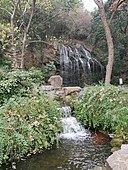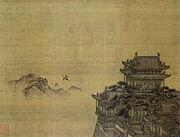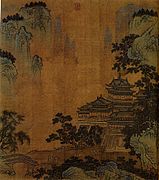Yellow Crane Tower (simplified Chinese: 黄鹤楼; traditional Chinese: 黃鶴樓; pinyin: Huánghè Lóu) is a traditional Chinese tower located in Wuhan. The current structure was built from 1981 to 1985, but the tower has existed in various forms from as early as AD 223. The current Yellow Crane Tower is 51.4 m (169 ft) high and covers an area of 3,219 m2 (34,650 sq ft). It is situated on Snake Hill (蛇山), one kilometer away from the original site, on the banks of the Yangtze River in Wuchang District.

| Yellow Crane Tower | |||||||||||||||||||||
|---|---|---|---|---|---|---|---|---|---|---|---|---|---|---|---|---|---|---|---|---|---|
 "Yellow Crane Tower" in Simplified (top) and Traditional (bottom) Chinese characters | |||||||||||||||||||||
| Simplified Chinese | 黄鹤楼 | ||||||||||||||||||||
| Traditional Chinese | 黃鶴樓 | ||||||||||||||||||||
| |||||||||||||||||||||


History

The Yuanhe Maps and Records of Prefectures and Counties, written almost 600 years after the construction of the tower, notes that after Sun Quan, founder of the kingdom of Eastern Wu, built the fort of Xiakou in 223, a tower was constructed at/on the Yellow Crane Jetty, west of Xiakou, and hence its name.[1][2]
The tower has been destroyed twelve times, both by warfare and by fire, in the Ming and Qing dynasties and was repaired on ten separate occasions. The last tower at the original site was built in 1868 and destroyed in 1884. In 1907, a new tower was built near the site of the Yellow Crane Tower. Zhang Zhidong proposed "Aolüe Tower" (Chinese: 奧略樓; pinyin: Àolüè lóu) as the name of this tower and wrote an antithetical couplet for it.[3] In 1957, the Wuhan Yangtze River Bridge was built with one trestle of the bridge on the Yellow Crane Tower's site. In 1981, the Wuhan City Government commenced reconstruction of the tower at a new location, about 1 km (0.62 mi) from the original site, and it was completed in 1985.[4]
Relic Protection
The Sacred Stupa (Chinese: 胜像宝塔; pinyin: Shèngxiàng Bǎotǎ) is 9.36 meters high and 5.68 meters wide. It is built with external stone and internal bricks, mainly stone masonry. A small amount of bricks are used in the internal tower room. It is the oldest and most complete single building preserved on the former site of the Yellow Crane Tower. The Sacred Stupa is a stupa of Tibetan Buddhism, and it is an example of the first type of stupa after Buddhism was brought from India to China. It is the only existing Lama-style white stupa in Wuhan, and it provides important physical materials for studying the history and religion of the historical and cultural significance of Wuhan in the late Yuan and early Ming Dynasties.
Legends

Notwithstanding the tower's current location on Snake Hill being unrelated to its original location one kilometre away, the two popular legends related to it invoke the hill. In the first, an Immortal (仙人) named Wang Zi'an (王子安) rode away from Snake Mountain on a yellow crane and a tower was later built in commemoration of this story. In the second legend, Fei Yi becomes immortal and rides a yellow crane, often stopping on Snake Hill to take a rest.[5]
The tower is also a sacred site of Taoism. Lü Dongbin is said to have ascended to heaven from here.[6] There is a small cave in the hill beneath the tower with Lü Dongbin statue. The cave has been called Lü Zu Dong,[citation needed] literately meaning cave of Lü Dongbin.
Literature
Poem by Cui Hao
Yellow Crane Tower was made famous by an 8th-century poem written by Cui Hao, titled "Yellow Crane Tower" (黃鶴樓).[7] The original text of the poem is shown below:
昔人已乘黃鶴去, 此地空餘黃鶴樓。
黃鶴一去不復返, 白雲千載空悠悠。
晴川歷歷漢陽樹, 芳草萋萋鸚鵡洲。
日暮鄉關何處是, 煙波江上使人愁。
A modern English translation is:
Long ago one's gone riding the yellow crane,[8] all that remained is the Yellow Crane Tower.
Once the yellow crane left it will never return, for one thousand years the clouds wandered carelessly.
The clear river reflects each Hanyang tree, fragrant grasses lushly grow on Parrot Island.[9]
At sunset, which direction leads to my hometown? One could not help feeling melancholy along the misty river.
Poem by Li Bai
There are other famous poems about the Yellow Crane Tower by Li Bai. One was written on the occasion of Li Bai parting with his friend and poetic colleague, Meng Haoran. The poem is titled "Seeing off Meng Haoran for Guangling at Yellow Crane Tower" (黃鶴樓送孟浩然之廣陵), and is shown in its original form below:
故人西辭黃鶴樓,
煙花三月下揚州。
孤帆遠影碧空盡,
唯見長江天際流。
A modern English translation is:[10]
My old friend bids farewell to me in the west at Yellow Crane Tower.
Amid March's mist and flowers he goes down to Yangzhou.
The distant image of his lonely sail disappears in the blue sky,
And all I see is the Long River flowing to the edge of sky.
Tourism
The tower and its surroundings have been marked as Yellow Crane Tower Park. There are tour services that can be hired for a fee at the entrance. The top of the tower has a broad view of its surroundings and the Yangtze River. Yellow Crane Tower is considered one of the Four Great Towers of China. In its modern version, it has the appearance of an ancient tower but is built of modern materials, including an elevator.[11] Each level has its own display. To the east on the hill, a large temple bell may be rung by tourists for a small fee. There are court dances in the western yard during the week-long National Day of the People's Republic of China celebration. The tower is classified as an AAAAA scenic area by the China National Tourism Administration.[12] At south side of the tower, there is a statue of Yue Fei because he was garrison around this area in Song Dynasty.
Gallery
- The Yellow Tower by Xia Yong, Yuan dynasty
- Yellow Crane Tower by Xia Yong, Yuan dynasty
- Yellow Crane Tower by An Zhengwen, Ming dynasty
- Yellow Crane Tower by Anonymous, Ming dynasty
See also
References
- Wan, Jingjun (Chinese: 万竞君; pinyin: Wàn Jìngjūn) 1982. Cui Hao Poem Annotations (simplified Chinese: 崔颢诗注; traditional Chinese: 崔顥詩注; pinyin: Cuī Hào Shī Zhù). Shanghai Ancient Books Press (Chinese: 上海古籍出版社; pinyin: Shànghǎi Gǔjí Chūbǎnshè). 54 pages.
External links

- Official website of Yellow Crane Tower
- 81641900 Yellow Crane Tower on OpenStreetMap










